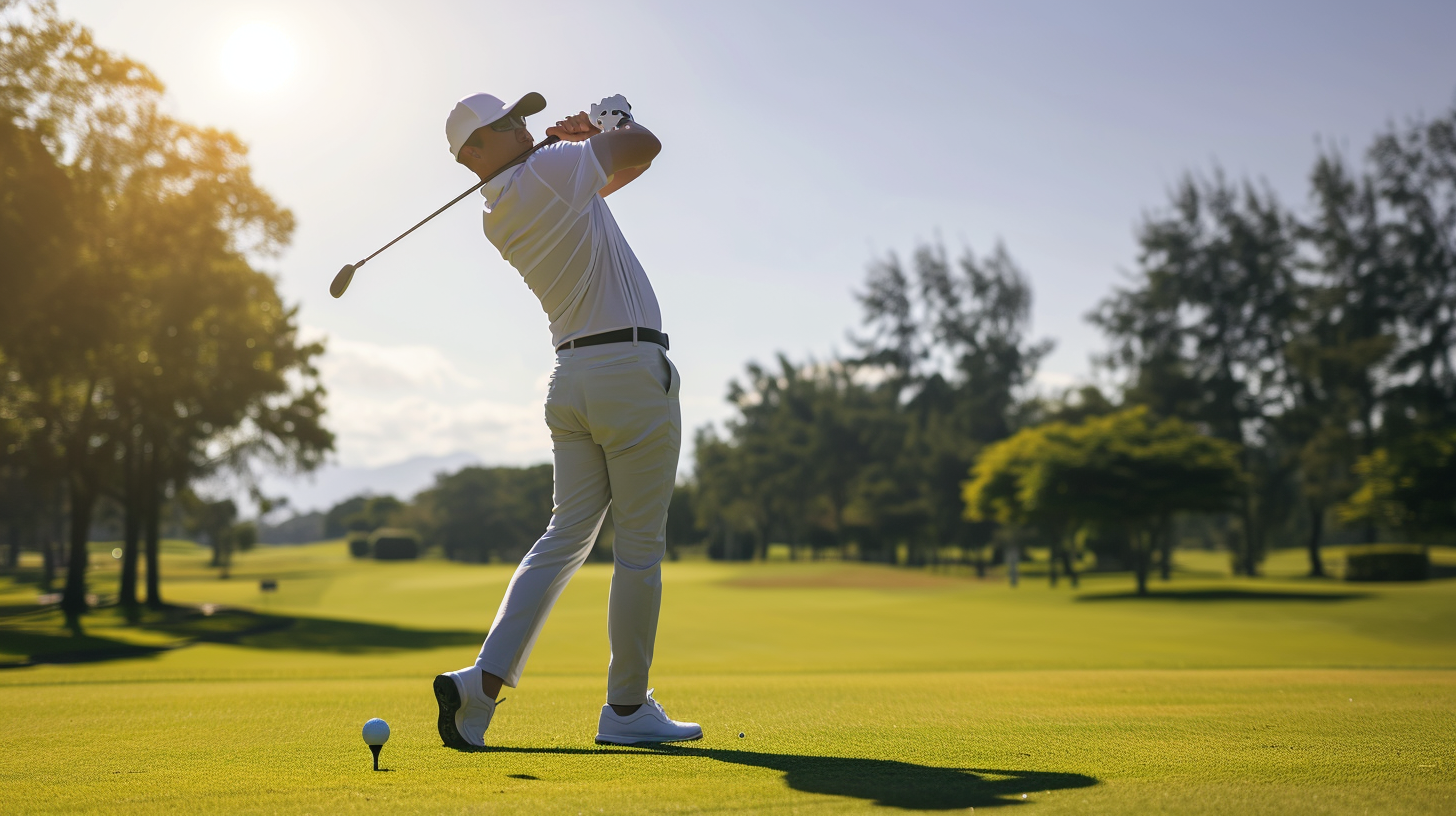Struggling to hit your golf ball straight and true off the tee or fairway lies? Slices, hooks and topped shots ruining your scorecard?
Learning optimal golf swing mechanics and repeatedly mastering essential impact factors delivers drastically improved shotmaking ability.
By digging into the keys below on proper setup, efficient motion sequences and mistake remedies, you gain the blueprint for conquering wayward shots. Let’s dive in to discover how to pure your golf ball striking for good.
How To Hit A Golf Ball

To hit a golf ball correctly, start by gripping the club with a neutral left hand and shoulder width stance, then position the ball forward of center towards your lead foot. Turn your shoulders smoothly on the backswing, shifting just your trail foot weight.
Transition into the downswing by firing your hips first so your arms and club catch up, retaining wrist hinge angle. Strike the ball then turf by releasing through impact, then hold your balanced finish after following through beyond the ball.
Getting setup elements like grip, alignment and ball position right along with proper sequence in the swing itself including shoulder turn, hip-led downswing and wrist release through contact will help you hit solid golf shots.
1. Have The Proper Setup And Stance
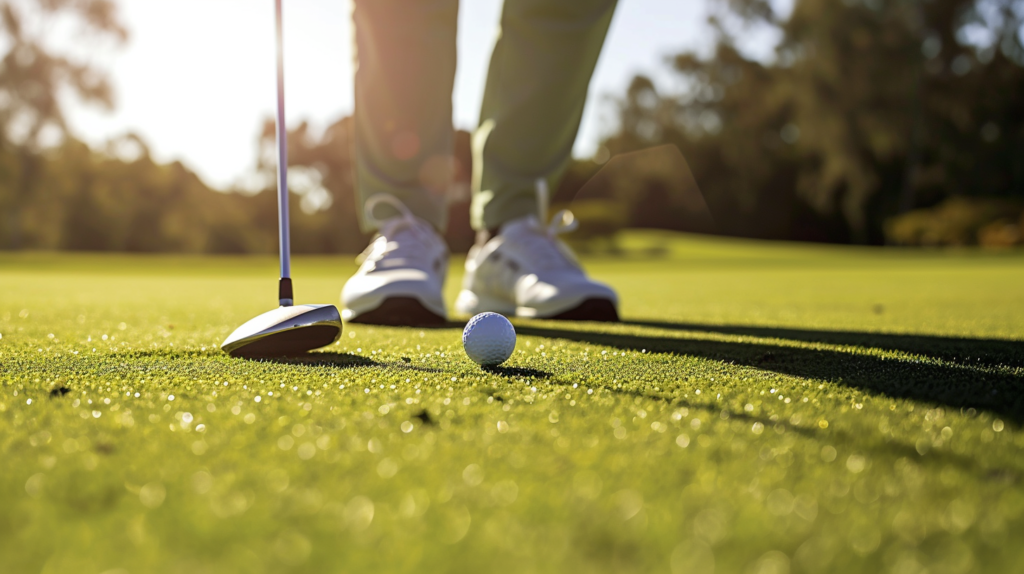
Having a proper setup and stance is crucial for hitting effective golf shots. There are several key elements to pay attention to when first approaching the golf ball and preparing to swing.
These elements include your grip and hand position on the club, feet positioning and stance width, posture and spine angle, as well as overall alignment of your body to your intended target.
Taking the time to dial in your setup will provide a solid foundation for an efficient golf swing. It also helps ingrain good form so that it becomes repeatable over time.
As you address the golf ball, be methodical about getting each aspect of your stance and body placement correct before making any movement with the club.
Grip And Hand Position On The Club
When gripping the club, you generally want to have a neutral left hand (for right-handed golfers) with two to three knuckles visible on your left hand.
Your right hand should have an overlap, interlock or baseball style grip to securely hold the club while still allowing hinging of the wrists. Make sure not to grip the club too tightly with either hand, maintain a light but firm grip pressure.
Check that the club rests primarily in the fingers and palms of your hands, not pressed against the pads of your palms. This hand position promotes better wrist hinging, which is essential during the proper golf swing motion.
Feet Positioning And Stance Width
Proper foot alignment and stance width builds a stable base to swing from. Aim to have your feet positioned parallel with the target line with toes pointed slightly outward.
Stance width varies by club, with feet generally being just wider than shoulder width apart. Driver stance may be several inches wider to allow for a sweeping motion.
Ensure weight distribution at setup is even between both feet. Do not sway or lean, instead maintain balance centered evenly between your heels and balls of feet.
This athletic posture readies momentum to be directed into the backswing.
Posture And Spine Angle
Good posture centers around a straight, neutral spine angle that supports upper body rotation. Bend slightly at the hips to achieve posture that has a flat back, relaxed neck and knees with a slight flex.
Do not over-bend to create too much depth in posture or round your upper back. Find an athletic posture balanced between being too slouched or rigid.
This neutral spine angle lets your core muscles properly stabilize body movements during the swing.
Alignment Of Body To Target
Once your grip, stance width and posture are set, align your body parallel to the intended target line. Use guide poles on the range and visual landmarks like trees or buildings to pick an intermediate target toward the landing area.
Square your stance, hips and shoulders towards that intermediate target. Avoid any contorted open or closed body alignments. Setting your stance and body aim properly distributes swing forces for accurate ball-striking.
2. Execute The Golf Swing
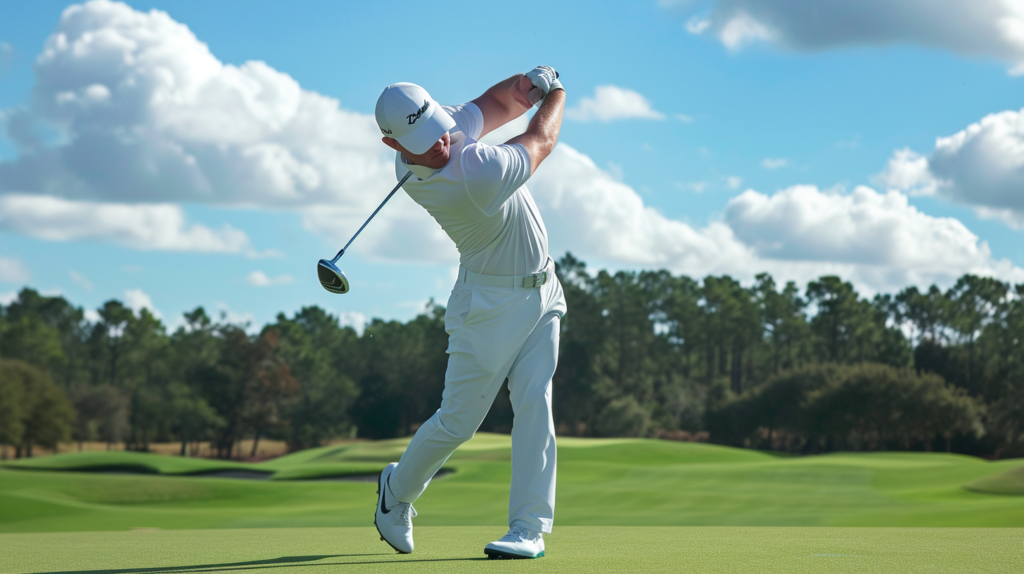
Executing a sound golf swing requires coordinating the movements of your body and club into one fluid motion. Breaking the swing down into backswing, transition, downswing, impact and follow through phases helps ingrain key positions.
Strive to make a balanced turn away from the ball during the backswing. Gathering momentum gracefully on the downswing to strike the ball solidly before holding your finish helps to groove an in-sync swing.
Backswing And Shoulder Turn
Initiate your backswing by turning your shoulders and letting the club follow a uniform swing plane. Shift weight onto your back foot without swaying laterally or dipping posture.
Allow arms and hands to lift the club controlled by the shoulder turn’s momentum.
Ideally turn shoulders on an inclined plane at approximately 45 degrees from vertical. This allows your arms to fold while preventing the club from getting too flat or upright.
For most clubs, make a three-quarters backswing shoulder turn bringing the shaft parallel to the ground.
Transition And Downswing
Transitioning smoothly is vital for proper timing that builds club head speed. Weight moves forward just ahead of the upper body starting downward rotation.
Utilize core and leg muscles to initiate downswing momentum.
Uncoil torso and arms in sequence, whipping the body through impact. Careful not to ‘over-clear’ hips sliding excessively front-wards.
Time hands and arms to lag slightly behind hip rotation at start of downswing. Unleashing this stored power accelerates the club into a forceful strike.
Impact And Ball Strike
Striking the ball requires adjusting your swing bottom to make solid contact with the equator of the ball. Brush turf slightly after impact when striking irons and fairway woods.
With the driver sweep the ball on upward trajectory.
Hands lead the downswing into impact, releasing club head lag built from proper wrist hinge and body torque. Hit the ball then turf with irons while ball is struck first then turf when using woods.
Compress your strike for efficient energy transfer to the ball.
Follow Through
Swing all the way through beyond ball impact, resisting the urge to quit on the shot. Hold your head still with eyes down through impact before lifting to observe the ball’s flight.
Allow weight to fully shift onto front foot while torso continues turning to face the target.
Ideally, finish the golf swing balanced with almost all weight pressed forward. This helps engage muscle sequencing for consistency while promoting flexibility needed to enhance swing mechanics.
3. Good Swing Tempo And Rhythm
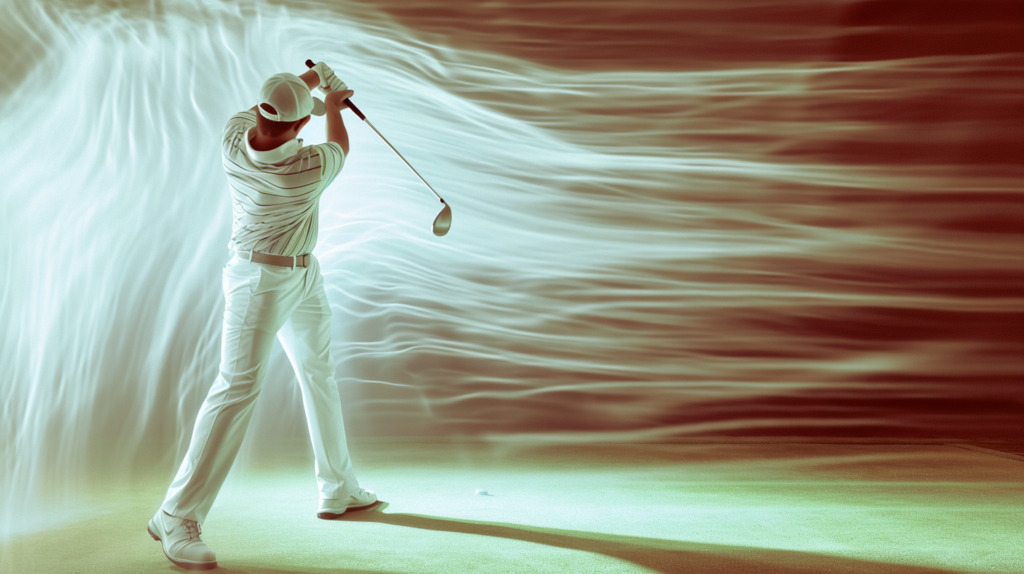
Grooving a steady tempo ties together the moving parts of an effective golf swing. Your tempo comprises the overall speed and timing of movements during the swing.
An optimal tempo utilizes momentum built via your body’s rotation rather than just hands and arms.
Importance Of Tempo
The tempo you swing with directly influences shot outcomes like direction, distance and accuracy. A rushed or jerky swing often diminishes solid contact resulting in inconsistent ball-striking.
Establish consistent pre-shot rhythms to help regulate tempo.
Count positional checkpoints during practice swings to ingrain an innate tempo. For most, an even one-two beat backswing joined by a firm one-two beat downswing provides ideal pacing.
Find a tempo that harmonicizes your athletic abilities for reliable shotmaking.
Finding Your Optimal Swing Speed
Swing at the fastest speed you can still control while making solid contact. Increased swing speed derives more power when combined with sound mechanics and timing.
Test incremental speed gains through use of video analysis and launch monitors while training.
Gauge appropriate speed for each club based on required distance along with wind and other playing conditions. Allow body motion to accelerate club speed rather than overly violent movements.
Learn optimal speed thresholds through purposeful experimentation at driving ranges.
4. Have A Good Ball Positioning
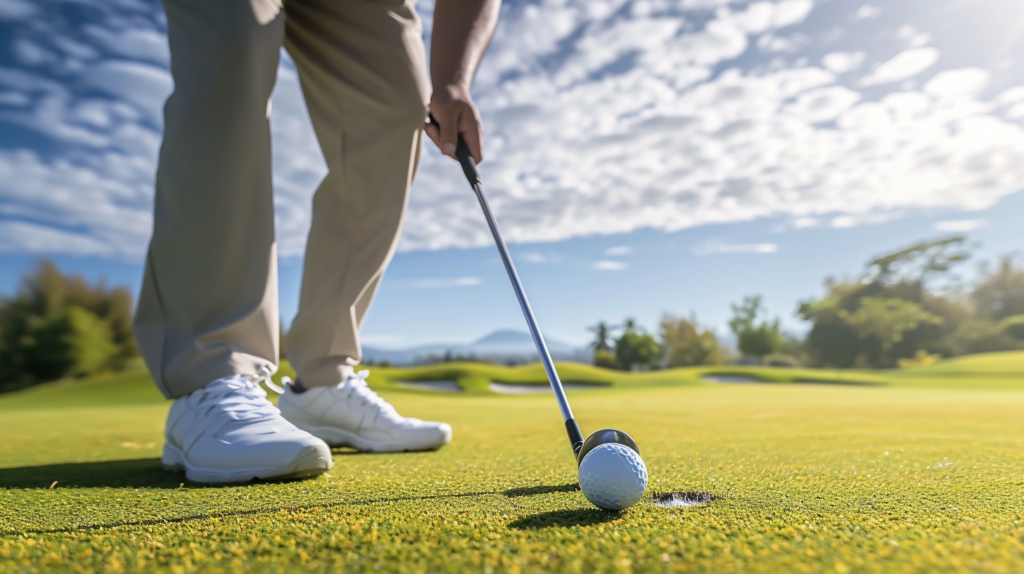
Consistently positioning the ball within your stance facilitates solid strikes with every club. Ball placement relative to your front foot mainly changes depending on which club you are hitting.
Certain adjustments may also be made based on playing conditions or specific shot shaping attempted.
Position At Address In Relation To Stance
Position the ball slightly forward of center between your heels for most full swing shots using irons and woods. Optimal ball position helps achieve efficient impact factors like centeredness, dynamic loft and swing bottom interaction.
Precise ball positioning in relation to foot flare varies individually but often aligns with the inside of lead foot’s heel for mid and short irons. Gradually adjust more forward towards inside of lead foot’s arch as you transition to longer irons and woods.
Adapting For Different Clubs
Certain clubs require adapting ball position for best results. Move ball alignment more towards lead heel when hitting lower lofted wedge shots. This helps prevent thin strikes while allowing room for steep angle of attack.
With the driver, position further forward, even with or inside lead foot instep. Teed ball location should promote upward driver head path just after impact for ideal launch angle and spin rates. Check impact marks and shot data to fine tune driver ball positioning.
5. Avoid Common Mistakes
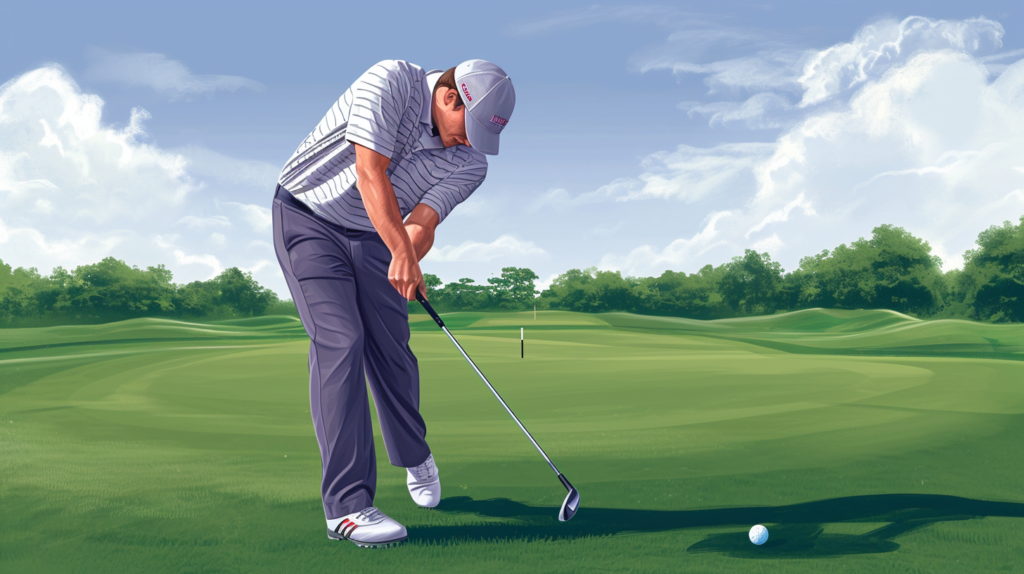
Most amateur golfers develop some common swing faults and mis-hits over time. Being aware of these tendencies along with their causes will help you self-diagnose then correct errors that lead to slicing, hooking, topping or thin shots.
Fixing these mistakes requires identifying swing characteristics like over-the-top downswings, scooping, swaying and others perpetuating poor ball striking. Instituting proper grip, tempo, release and swing path remedies conquers these deficiencies long term.
Slicing And Hooking
Both slicing and hooking result from an open or closed club face relative to swing path at impact. Slices are hit with open club face and in-to-out downswing.
Hooks have closed face and out-to-in downswing.
Use alignment stick trainers placed on ground to monitor proper swing path. Check wrist conditions at impact to abolition slices and hooks by adjusting grip, release or swinging more up/down the target line.
Topping The Ball
Topping most often stems from dipping posture, relaxing wrists or shifting weight poorly during downswing. Maintain posture and spine angle while resisting upper body curving onto rear foot through impact.
Ensure proper weight transfer staying behind the ball then fully onto front side post-impact. Increase wrist cock angle and firmer hands to keep leading edge down, compressing ball then turf for more consistent solid contact.
Coming Over The Top
An over-the-top move features an out-to-in downswing across the ball and towards the left pulled by the upper body and shoulders (for righties). Avoid rolling hands or forearms prematurely on takeaway since this commonly precedes downswing faults.
Set front shoulder externally rotated at address to promote inside swing path. Feel like you draw the clubhead more from the inside keeping hands inside front shoulder longer before releasing outwards.
This engrains correct sequencing stabilizing swing direction.
6. Improving Consistency
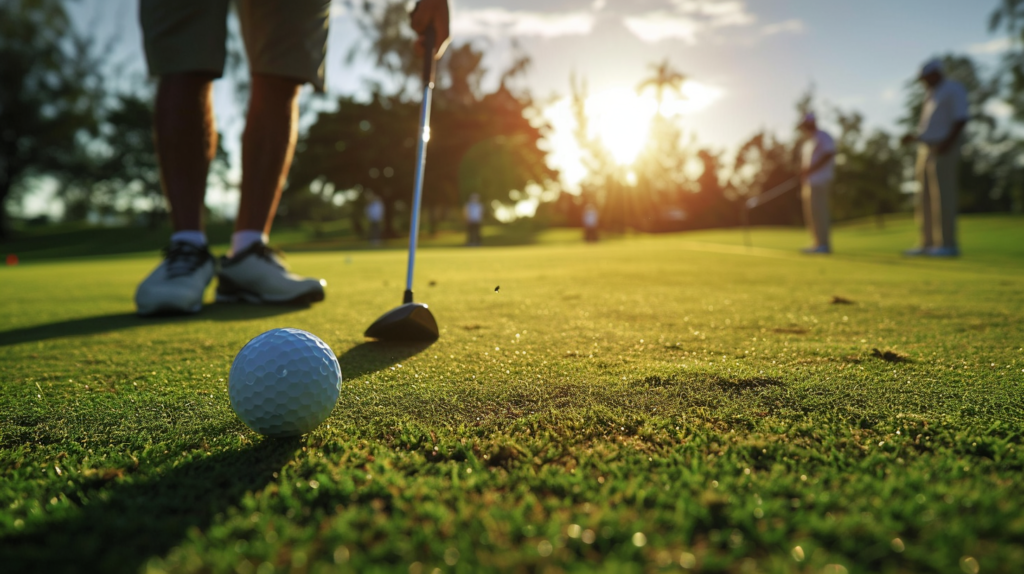
Developing reliable ball striking and directional control happens over time by working on proper alignment, swing techniques and ingraining feel through practice. Seeking feedback from instruction combined with self-analysis advances your consistency faster.
Alignment And Aim
Sound alignment ties your setup directly to targets allowing swing motions to be focused on direction. Always take practice swings oriented on intermediate aiming lines, rehearsing the exact intended start and release moves.
Verify alignments with secondary checkpoints like hanging clubs or shadows matching parallel to feet, knees, hips and shoulders. Consistent orientation, posture and ball positioning builds consistency through repetition.
Practice Routines
Implement purposeful practice routines aligned to your improvement goals. Don’t just beat balls but train with intent on refining positions, tempo or specific trouble shots.
Design sessions focused on priorities like alignment, troubleshot cures or technique refinement.
Choke down for reduced shot lengths that isolate positions. Place impact sprays, foot powder or video to check improvements on focused items repeatedly for lasting changes.
Evaluate performance metrics to monitor progress over time.
Lessons And Coaching
Supplement self-directed training with instruction from a PGA professional utilizing video analysis, launch monitors and proven coaching experience.
Let the coach identify limitations then design practice plans to conquer those weak points through personalized direction techniques.
The coaching feedback loop accelerates changes through accountability to implement prescribed drills and fixes.
Together examine shot data like spin rates, launch angles and curvature to create lesson plans pinpointed to your exact improvement needs for quicker consistency gains.
Conclusion
Hitting a golf ball well requires ingraining proper setup, backswing, transition, downswing, impact and follow through positions. Mastering key checkpoints like grip, posture, alignment and weight transfer ensures technique deficiencies do not hold back your shooting consistency.
Implement purposeful practice sessions focused on positions and drills that conquer your personal swing errors. With sound fundamentals and an understanding of ball flight principles, every golfer can hit quality shots by training smart.
